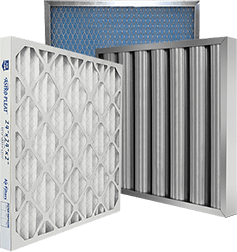What is filter pressure drop?
An air filter’s pressure drop is the measurement of resistance to air that passes through the filter. The more tightly woven or thick a filter’s media is, the more particles and contaminates the filter can trap. This often coincides with a higher MERV rating; however, this also means that the filter is slightly more restrictive and the airflow rate through the filter is lower. There is still a common misconception that having a high MERV rated filter will be too restrictive and strain your unit. However, most HVAC systems built in the last 20 years should have no issue using a MERV 6 - MERV 13 rated air filter. You can help minimize the risk of HVAC equipment issues or damage from pressure drop, by regularly changing your air filter. While it is true that the more the air filter traps the more effective it is at capturing more particles; it will eventually become too loaded, at which point, the airflow could be zero and extremely restrictive. Which is not recommended, and could cause increased energy bills, and undue wear on your HVAC unit. Frequent filter changeouts will help minimize risks from pressure drop.
How is filter pressure drop measured?
Pressure drop is defined by the National Air Filtration Association (NAFA): The pressure drop of a filter is a measure of its resistance to airflow through it. Resistance is measured in inches water gauge (w.g.) in the Inch-Pound system of measurement. It is measured in Pascals in the SI system.
What initial pressure drop vs. final pressure drop?
A filter’s pressure drop is measured twice, once when the filter is brand new and again when the filter has been in service and is “loaded” with trapped air pollutants. The filter’s initial pressure drop (initial resistance) will vary by the filter type, MERV rating, and size. When a filter is in use, it traps and gathers particles, the more particles that are trapped the harder it is for air to pass through; when this occurs the filter’s pressure drop rises. Once the filter is fully loaded the filter will reach its final pressure drop. The final pressure drop/final resistance is measured when the filter has reached its total dust holding capacity and is ready to be replaced. It is not recommended to continue to use your filter beyond it’s final pressure drop point. Doing so could cause strain on your HVAC unit and could cause costly maintenance and repairs.
Does air filter's pressure drop change?
As dirt and debris gets trapped by the filter, there is less space for air to pass through, causing the pressure drop to rise throughout the filter’s life. This one of the main reasons why it is so important to check, change, and clean your air filter every month to help ensure your air filter’s pressure drop does not get too high and cause strain on your air conditioner/handler. Remembering to change your air filter is key to reducing the risk from pressure drop.
What is static pressure?
Static pressure is the measurement of the exertion of air flow your HVAC system is moving throughout the system and ductwork.
What are the signs of unhealthy static pressure in an HVAC system?
Noisy systems when running, high static pressure could be the culprit. Hot or cold spots throughout your home? This could be because your system is moving too much or not enough air through its ductwork.
What is the relationship between filter pressure drop and air flow rate?
A filter’s pressure drop directly corresponds to a filter’s air flow rate. The higher the pressure drop the more restrictive the filter is to air flow. The lower the pressure drop the easier it is for air to flow through the filter. This is important to consider when choosing a filter for your application and your HVAC unit. Most current home HVAC units can accommodate a filter with a MERV 13 or lower. A 1” MERV 13 pleated filter has a pressure drop of around 0.27, and a 1” MERV 8 has a pressure drop of around 0.14.
How does filter pressure drop affect flow rate?
When you air filter is installed, it is a barrier between your HVAC and your ducts/vents. When your HVAC system is running the filter slows and limits the air that is being pulled through your vents and ducts. The amount of the HVAC’s air flow slowed by the filter is equivalent to the filter’s pressure drop. Typically, the higher the MERV rating, the higher the pressure drop and the more restrictive the air flow is. Pressure drop directly corresponds to a filter’s air flow rate.
Does the material (ex: fiberglass) affect the pressure drop of the filter?
Filters use various types of medias depending on the application or what the environment requires. A filter’s material type and efficiency rating affect the pressure drop and resistance to air flow. For example, a household pleated filter that uses synthetic media will have a lower pressure drop than a micro-fiberglass media that is used in critical environments such as a hospitals and datacenters.
Pressure Drop Comparison - MERV 8, MERV 11, & MERV 13
The higher the filtering efficiency rating (MERV rating), the higher the pressure drop. This also means that as the MERV rating goes up, the more particles and contaminants the filter can capture. Below is a chart comparing the pressure drop of standard 20X24X1 MERV8, 11, and 13 at 1000 CFM. Most current household HVAC units/handlers can handle a MERV 6-13 pleated filter with ease. Always refer to your HVAC systems manufacturer’s guide prior to changing your air filter.
|
MERV |
Nominal Size |
Actual Size |
CFM |
Pressure Drop |
|
13 |
20X24X1 |
19-1/2” X 23-1/2” X 3/4” |
1000 |
0.27 |
|
11 |
20X24X1 |
19-1/2” X 23-1/2” X 3/4” |
1000 |
0.27 |
|
8 |
20X24X1 |
19-1/2” X 23-1/2” X 3/4” |
1000 |
0.14 |
Do higher MERV rated filters restrict air flow?
The higher the MERV rating the more efficient the filter is at filtering out and capturing air particles and contaminants. As the MERV rating increases the media typically becomes loftier and thicker, to capture more air pollutants, with this you could see slightly more air restriction. However, we use a pleated accordion style media, that allows us to effectively increase the filter’s surface area without having a high pressure drop or restricting air flow. Most current household HVAC units/handlers can handle a MERV 6-13 pleated filter with ease. Changing your air filters regularly will prevent filters from being loaded and overly restrictive.
What pressure drop is safe for my AC/Air Handling System?
The accepted pressure drop is different for each air conditioning or air handling system, and you should always refer to your manufacturer’s guide prior to inserting replacing your air filter to ensure you are using the appropriate filter. Most current household HVAC units/handlers can handle a MERV 6-13 pleated filter with ease.
Each air filter has its own unique pressure drop. Even filters sharing the same MERV rating may have differing pressure drops. Many pleated HVAC air filters can still have a high MERV rating, while not drastically restricting air flow. Always refer to your air handler manufacturer’s guide before changing your air filter.
HEPA, ULPA, & ASHRAE Filter Pressure Drop
The pressure drop for highly efficient filters like HEPA, ULPA, and ASHRAE tends to be higher, they use a quality filter media that is excellent at capturing pollutants and fine particles. HEPA, ULPA, and ASHRAE filters are typically used in commercial and industrial environments or in applications.
Additional Factors Affecting Pressure Drop
A filter’s pressure drop changes throughout it’s use. As a filter traps and gathers airborne contaminants the filter’s pressure drop increases and air flow decreases. Frequent filter changeoutsare necessary to reduce the possible negative effects a loaded filter can have on your HVAC equipment.
There are no products matching the selection.
Customize Your Air Filter in 4 Easy Steps
APPLICATION

EFFICIENCY

DIMENSIONS

DELIVERY


Air Filters, Inc. is committed to providing a "one-stop shop" for all of your air filtration requirements. As an air filter manufacturer, we are uniquely positioned to custom make any and all types of air filters.
build your custom filter now
Have a Question?
Send us a message below or call us at 1.800.667.8563
Resources
-
Track My Order
Ordered your filters and need to know where they are?
-
Careers
Want to work for Air Filters Inc.? We are hiring!
-
Glossary
Browse a full list of industry terms to better choose your filters.
-
Download Catalog
Receive our full product catalog via email.
-
Affiliates
View all of our Company Brands.
-
Video Library
Need to know how to install your filters? Watch helpful videos from AFI.






